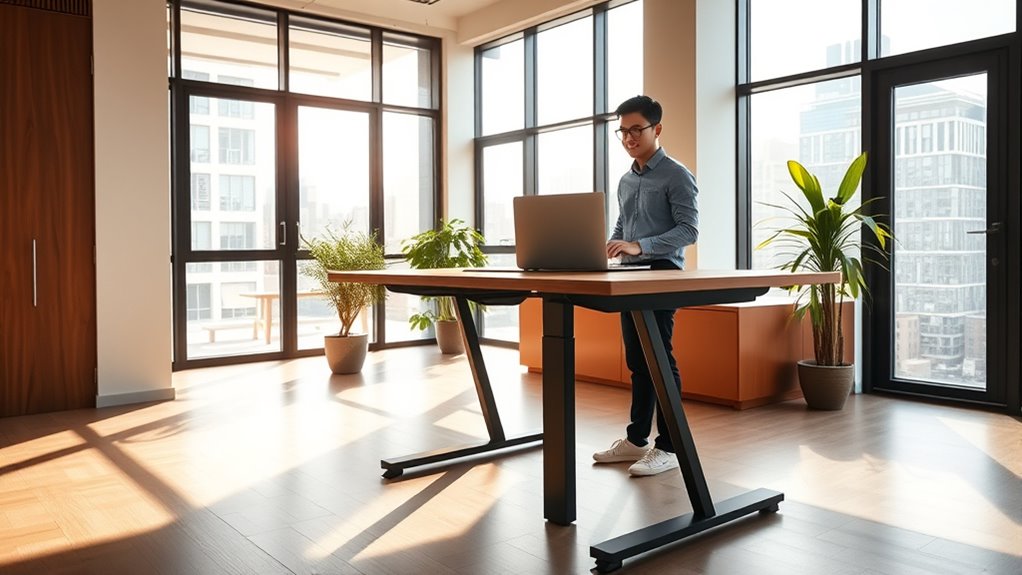Standing desks can be more than just hype if you use them correctly. When properly adjusted and combined with regular breaks, they help improve posture, boost focus, and reduce health risks linked to sitting all day. However, standing all the time without proper support may cause fatigue or discomfort. To truly benefit, you need a balanced approach with ergonomic setup and movement. Keep exploring to discover how to maximize your standing desk’s potential.
Key Takeaways
- Standing desks can improve posture and reduce back pain when used with proper ergonomic setup.
- Their benefits depend on correct height adjustments, supportive footwear, and regular breaks.
- Standing increases alertness and focus, boosting productivity and mental clarity during work.
- Prolonged standing without support may cause fatigue or joint strain, requiring balanced sitting and standing.
- When used thoughtfully, standing desks are effective tools for enhancing health and work experience, not just hype.

Have you ever wondered if standing desks could transform your workday? Many people jump into trying them out, hoping for immediate results, but it’s worth understanding what they truly offer. Standing desks are often praised for their ergonomic benefits, which aim to improve your posture and reduce common issues like neck and back pain caused by prolonged sitting. When used correctly, they encourage better alignment of your spine, decrease pressure on your lower back, and promote natural movement throughout the day. This can lead to a more comfortable working experience, especially if you’re prone to stiffness or discomfort from sitting too long. However, the ergonomic benefits aren’t automatic—they depend on proper desk height, supportive footwear, and taking regular breaks to switch between sitting and standing. If you ignore these factors, you might not experience the full benefits, or worse, you could develop other issues like leg fatigue or joint strain.
Beyond comfort, many users are curious about the productivity impact of standing desks. Some claim that standing helps them stay more alert, focused, and energized. When you’re standing, your blood circulation improves, which can boost mental clarity and reduce the sluggishness that sometimes comes from sitting for hours. Additionally, standing encourages more movement, making it easier to stretch or shift positions, which can combat the sluggishness associated with static sitting. The result is often a more dynamic work environment where you feel less sluggish and more engaged. That said, standing all day isn’t a guaranteed productivity boost for everyone. It can initially be tiring, especially if you’re not used to it, and standing for extended periods without proper support can lead to discomfort. The key is to find a balance—alternating between sitting and standing to maintain comfort while enjoying the benefits of increased activity. Incorporating ergonomic adjustments can further enhance the effectiveness of a standing desk.
Ultimately, whether standing desks are a hype or a health game-changer depends on how you implement them. If you approach them with proper ergonomics, listen to your body, and incorporate movement, they can profoundly improve your workday. But if you jump in without preparation or ignore the need for breaks, the potential benefits could be overshadowed by discomfort. Think of a standing desk as a tool that, when used thoughtfully, can enhance your posture, boost your focus, and help you avoid some of the health issues linked to prolonged sitting. It’s not a magic fix, but many find that with proper use, standing desks can genuinely transform their work experience for the better.
Frequently Asked Questions
Are Standing Desks Suitable for All Body Types?
Not everyone finds standing desks suitable, as body types vary. You should consider ergonomic adjustments and height customization to make them comfortable. If you have specific needs or health concerns, modify the desk to support proper posture and reduce strain. Listening to your body is key—if standing causes discomfort, alternate with sitting and take breaks. Proper setup ensures your standing desk benefits your health without causing unnecessary strain.
How Do Standing Desks Impact Long-Term Posture?
Standing desks can positively impact your long-term posture when you make proper ergonomic adjustments. They encourage you to sit less and incorporate sitting alternatives into your routine, reducing strain on your neck, back, and shoulders. By regularly switching between sitting and standing, you promote better spinal alignment and muscle balance. Just remember to adjust your desk height and monitor position to guarantee comfort and prevent new postural issues from developing.
Can Standing Desks Help Reduce Chronic Back Pain?
Chronic back pain can feel like an endless burden, but standing desks offer relief by promoting movement and reducing strain. You can optimize benefits with ergonomic accessories and balanced sit-stand ratios, preventing stiffness and discomfort. While standing more isn’t a cure-all, it encourages better posture and activity, helping you manage pain over time. Incorporating these strategies can make a significant difference in your back health and daily comfort.
What Are the Best Practices for Transitioning to Standing Desks?
To make a smooth sit-stand shift, start slowly by alternating between sitting and standing every 30 minutes. Use ergonomic accessories like an anti-fatigue mat and adjustable monitor arms to stay comfortable. Listen to your body, gradually increase standing time, and maintain good posture. This approach helps prevent fatigue or strain, making your switch to a standing desk both effective and sustainable.
Do Standing Desks Improve Productivity and Focus?
Like the myth of Icarus soaring higher, you might wonder if standing desks truly boost productivity and focus. They offer ergonomic benefits that reduce discomfort, helping you stay alert longer. Standing can increase energy levels, making it easier to concentrate on tasks. While results vary, many find that alternating between sitting and standing improves focus and efficiency, turning your workspace into a more dynamic, health-conscious environment.
Conclusion
So, are standing desks just a fleeting trend or a true health game-changer? Think of them as a bridge over a sea of sedentary habits, offering you a chance to stand tall against health risks. They may not be perfect, but they can turn your workspace into a vibrant landscape of movement. Ultimately, it’s your choice—will you let sitting drown your well-being, or will you stand up and take control?









